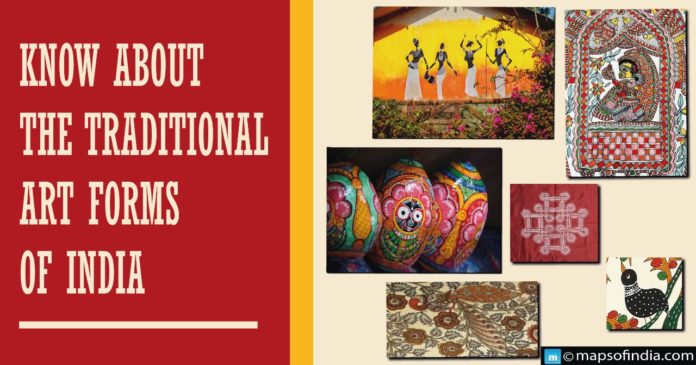India has a diverse cultural legacy, including several types of traditional arts. These conventional arts are manifestations of several civilisations inside the country, and each one is distinct from others. Every state has its unique art form, and they are all stunning. These arts decreased for a while, but they are now prospering due to a renewed interest in local artists.
Some of the various traditional art styles found in India include:
- Warli Art
Warli art is unique to the tribal districts of Thane and Nashik in Maharashtra, and it consists of wall paintings made by women of Warli, Kokana, Kathodi, Dhodi, and Malkhar kholi. These tribes are primarily from Western India and live in the northern suburbs of Mumbai. This art was initially discovered imprinted on the mud walls of local cottages in the early 1970s. The Warli painting reflects societal situations rather than scenes from Indian epics.
- Chittara Art
The Chittara art form is recognised and performed by the Deewaru group in the Karnataka regions of Shimoga, Uttar Kannada, and Sagara. The walls of the homes are coated in red mud, and white artwork is made using rice paste and white mud on top of it. As with many traditional arts, the main components are entirely natural, comprising tree barks, seeds, coal, rice flour, and berries, to mention a few. A special brush consisting of natural threads and grass fibre is used to paint the walls, door frames, window frames, and floors.
- Pata Chitra
Pata Chitra is a traditional art style practised in various areas, including Orissa and West Bengal. The Bengali form of the art is known as Pata Chitra, and their use of bright colours distinguishes the paintings. Spices, soot, soil, flowers, and a range of other natural substances were used to obtain the colours. The artwork represented regressive societal activities to deter individuals from engaging in them. The art, which dates back hundreds of years, is associated with when nomadic minstrels roamed the state singing about life and problems.
- Gond Art
Gond art is a style of Indian traditional art that originated in the tribal regions of central India. The paintings represent rivers, hills, streams, and woods and are inspired by the Gond people’s environment. The Gond art commands attention, created on the walls, ceilings, and floor during customs and festivals. The paintings are unique because they are made with a succession of dots and dashes that are wonderfully grouped into patterns and images. The form of art is related to the tattoo culture that is very common nowadays.
- Kalamkari Art
In Hindi, Kalam signifies pen, while Kari means effort. This work is done with beautiful bamboo pens handcrafted by artisans. This distinct painting style evolved in Kalahasti, near Chennai, and Masulipatnam, near Hyderabad. During the Maratha administration, Kalamkari thrived, and some artworks had Persian elements as well. The most common source of paints is vegetable inks. Karuppur, a newer style, has the cloth embellished with golden brocade and is intended for royal households.
- Madhubani Art
Madhubani art is primarily done in Northern India’s Bihar and Nepal’s Mithila area. The artworks are mostly nib pens, twigs, brushes, and occasionally even fingers and matchsticks. Likewise, women have been doing the artwork in the areas for generations. The paintings feature a distinct geometrical layout.




